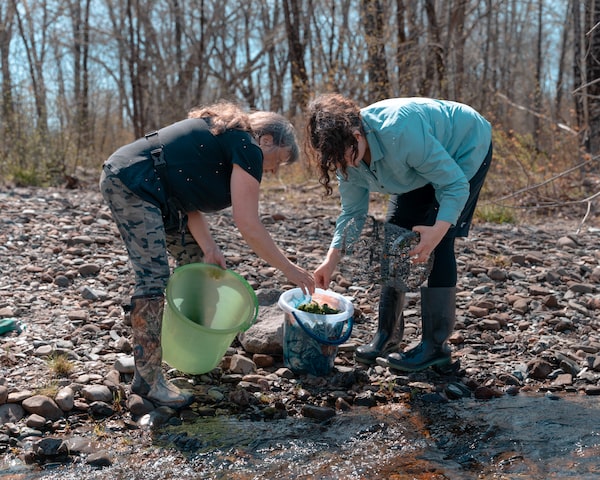
Brenda Jonca, left, and Mira Gervais wash fiddleheads in a brook in southern New Brunswick.Photography by Matt Horseman/The Globe and Mail
Brenda Jonca is driving slowly past a meadow, her eyes scanning the patches of thick, new spring grass, when her black pickup truck stops suddenly and her right arm points out of the open passenger window.
“Oooh, look at those humps,” she says, motioning toward a row of green mounds on the far side of the field. “You look at those humps over there and you tell me there ain’t fiddleheads coming up.”
If anyone can spot fiddleheads from behind the wheel of a moving vehicle, it’s Ms. Jonca. The 64-year-old great grandmother, clad in camouflage pants and rubber boots, has a sixth sense for tracking this delicacy of New Brunswick’s forests.
Here, where the great Saint John River opens up and winds past dark green mountains and faded century farms, annual spring floods produce some of the best fiddleheads in the world. And few know better how to find them than Ms. Jonca.

Ms. Jonca, left, grew up in Evandale, N.B, and would often join her father on family fiddlehead-picking trips in the woods.
The fiddlehead is a delicate thing. It can be harvested for only a few weeks a year and the tightly wound coils must be picked by hand, often while fighting off clouds of blackflies and the occasional bear. One day of heat, or a night of frost, can ruin the plant. But the reward, for those who patiently forage them from the woods, is a food prized by rural diets and urban foodies alike – a grassy fern that tastes something like an earthier cross between asparagus and young spinach.
Ms. Jonca has agreed, somewhat reluctantly, to take a pair of visitors to a patch hidden deep behind a farmer’s field, where only a handful of people know there is good fiddlehead picking. She suggests they leave their cars down the road and drive with her, to avoid detection. She has made them swear not to share the location.
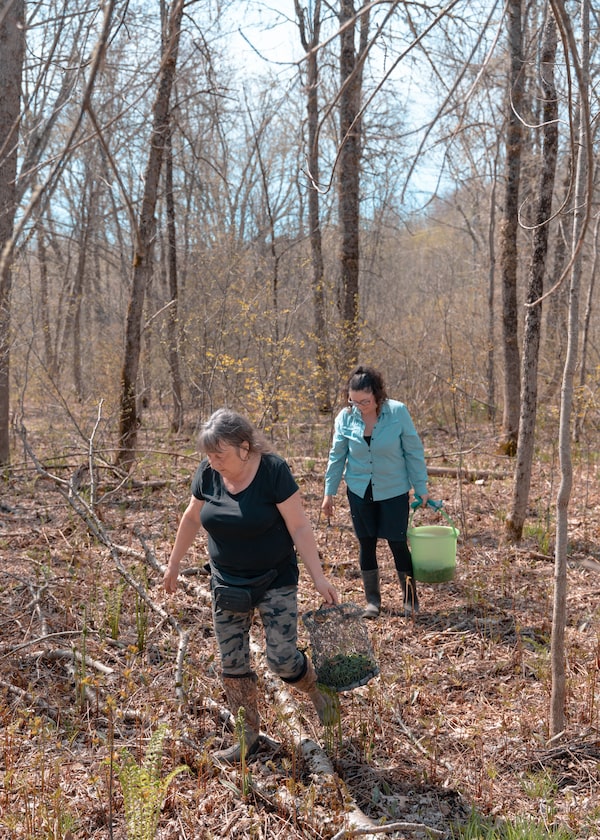
In the world of secret fiddlehead patches and suspicious pickers, one person has earned Ms. Jonca's trust: Mira Gervais, her new neighbour.
“You should probably wear a blindfold,” she says. She is only half joking.
People around here still talk about the time someone told a local newspaper reporter about the best brook in which to catch trout. The next year, there were no fish left, Ms. Jonca said. There should be no surprise that inside New Brunswick’s secretive fiddlehead community, the most experienced pickers are always deliberately vague.
“People ask me all the time where I get my fiddleheads. I just say, ‘Oh, up a brook,’” she says, laughing.
In this mysterious world of secret patches and suspicious pickers, one person has earned her trust: Mira Gervais, a 39-year-old from British Columbia, who recently became Ms. Jonca’s neighbour. She’s taking Ms. Gervais under her wing this spring, teaching her the art of finding, picking and preserving fiddleheads.
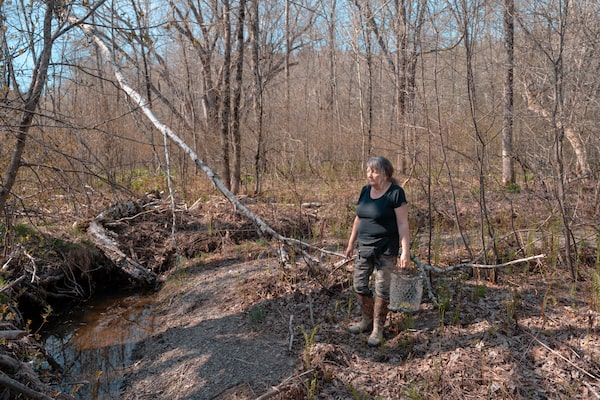
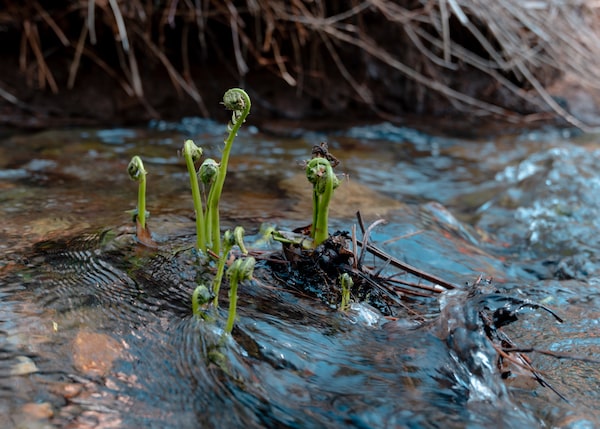
Fiddleheads can only be harvested for a few weeks a year, and the tightly wound coils must be picked by hand.
Ms. Jonca, who says her own children and grandchildren are too busy to carry on the tradition, is worried her wisdom will be lost if she doesn’t pass it on. She has a bad back – she hurt it carrying heavy pails of fiddleheads last spring – and says her days of tromping through the woods are numbered.
“I feel honoured I’m getting this knowledge passed down to me,” Ms. Gervais says. “It’s a form of survival, and it’s an important skill to know how to forage and how to take care of yourself.”
She sells her fiddleheads on Facebook, where they’re quickly snapped up. Fiddleheads are as versatile as they are delicious and nutritious, she says. They can be creamed, steamed, roasted and sautéed. Ms. Jonca likes hers boiled until they’re soft, with butter and salt. Ms. Gervais prefers them slightly al dente, with a bit of vinegar.
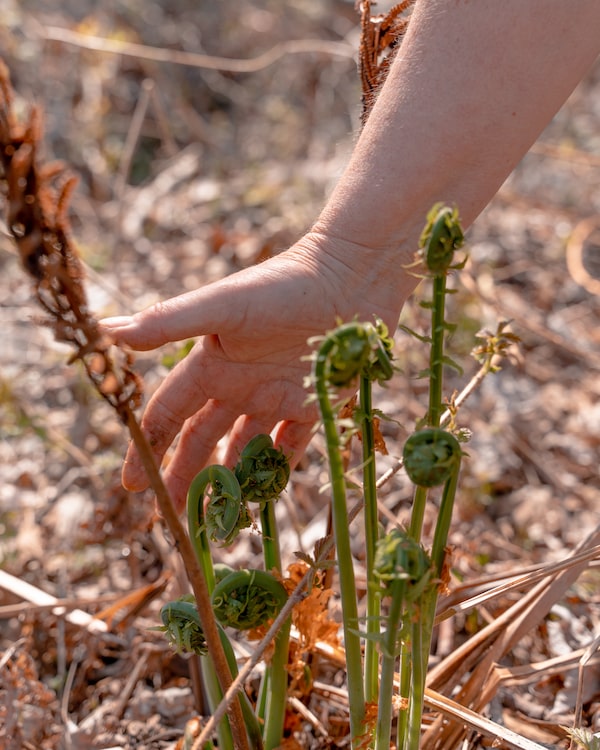
Ms. Jonca shows fiddleheads that are ready to be picked.
While Ms. Jonca walks, her eyes always scanning the ground, she talks of patches so thick with fiddleheads that a picker can sit down and fill their bucket without moving. Of plump, ripe fiddleheads the size of toonies. Of the perfect “first-pick” fiddleheads that may be available for just a day or two a year.
“Those places are just polluted with fiddleheads,” she says. “When you find them, you know it. You could fill up a pillow case in no time.”
Ms. Jonca knows these places because this land is a part of her. She grew up in Evandale as one of eight children and would often follow her father for long family picking trips into the woods. The kids couldn’t leave until their bags were full; adding the fiddleheads to a freezer already full with moose meat, trout, deer, blueberries, strawberries and vegetables from their own garden.
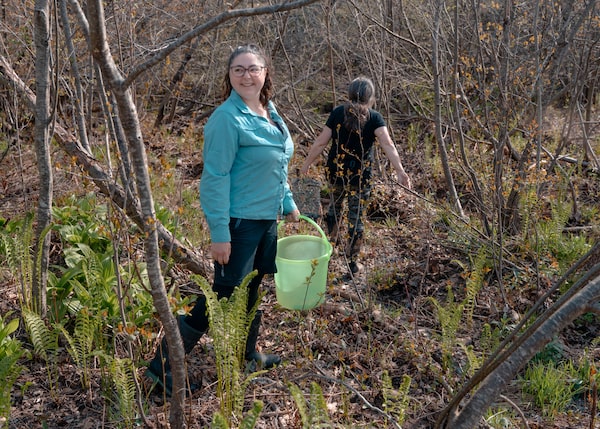
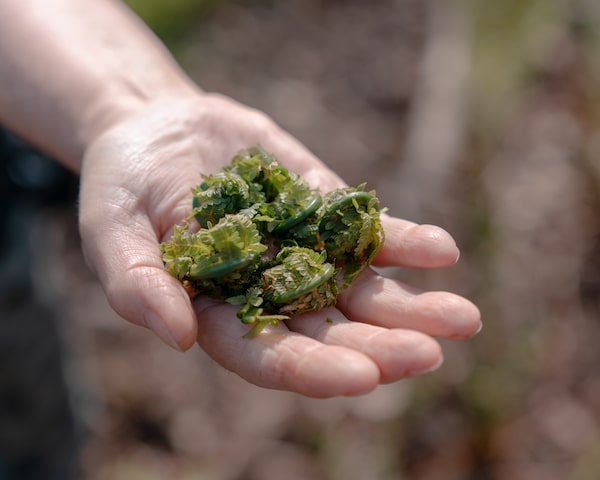
Ms. Gervais (above, left) says she had never even seen a fiddlehead before moving to New Brunswick from Whistler, B.C.
They knew all the best fiddlehead patches, discovered while fishing the brooks or cutting lumber. Ms. Jonca also knows the best place to stop and get a drink from a mountain spring, where the water tastes somehow sweeter than anything from a tap. Her father is buried on a hill not far away.
“Hi, Dad,” she says, waving her hand out the window as she drives by the cemetery.
All of this is new for Ms. Gervais, 39, who grew up in Whistler, B.C., a long way from fiddleheads. Picking with Ms. Jonca has been an introduction to New Brunswick’s rural culture and has reinforced her own values of self-sufficiency. She’s learning that fiddleheads growing near brooks must be picked sooner than those along the river’s edge, that they can quickly stain your fingernails green and how they must be blanched before frozen.
And most importantly: If you’re going picking in a secret spot, it’s best to blend in.
“She wanted me to wear camo to come out with her, but I don’t own any,” Ms. Gervais says. “I didn’t know about any of this stuff. I’d never even seen a fiddlehead before I moved here.”
The problem with fiddlehead season is that it’s so short. You have perhaps two weeks of picking, before the fiddleheads unfurl and become inedible. Next Tuesday, a funeral is planned for one of Ms. Jonca’s aunts. It’s unfortunately right when one of her favourite patches will also be primed for picking, and she’s torn about what to do.
Ms. Jonca, squinting against the late morning sun, says her aunt appreciated a good feast of fiddlehead as much as anyone. She shrugs. “She’d understand if I didn’t go.”
Our Morning Update and Evening Update newsletters are written by Globe editors, giving you a concise summary of the day’s most important headlines. Sign up today.
 Greg Mercer
Greg Mercer